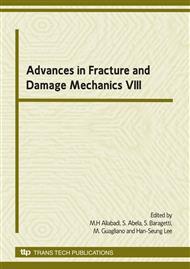[1]
K. Yanaida, A. Ohashi, Flow characteristics of waterjets in air, 4th international symposium on jet cutting tecnology, (1978).
Google Scholar
[2]
K. Yanaida, Flow characteristics of waterjets in air, 5th international symposium on jet cutting technology, (1980).
Google Scholar
[3]
M. Hashish, M. Ramulu, S. Kunaporn, Mathematica modeling of ultra-high-pressure waterjet peening, transaction of the ASME, vol. 127, (2005).
DOI: 10.1115/1.1857934
Google Scholar
[4]
G. Motter, Pallinatura waterjet, un'applicazione innovativa al trattamento delle superfici, Master thesis, Politecnico di Milano, 1997-(1998).
Google Scholar
[5]
H. Soyama, J. D. Park, M. Saka, Use of cavitating jet for introducing compressive residual stress, Journal of manufacturing science and engineering, (2000).
DOI: 10.1115/1.538911
Google Scholar
[6]
H. Soyama, D. O. Macodiyo, Optimization of cavitation peening parameters for fatigue performance of carburized steel using Taguchi method, Journal of materials processing technology, (2006).
DOI: 10.1016/j.jmatprotec.2006.03.172
Google Scholar
[7]
M. Qin, D.J. Ju, R. Oba, Improvement on the process capability of water cavitation peening by aeration, Surface and coatings technology, (2006).
DOI: 10.1016/j.surfcoat.2005.06.024
Google Scholar
[8]
H, Soyama, D. Odhiambo, Cavitation shotless peening for improvement of fatigue strength of carbonized steel, international journal of fatigue, (2003).
DOI: 10.1016/s0142-1123(03)00121-x
Google Scholar
[9]
M. Hashish, M. Ramulu, S. Kunaporn, M.G. Jenkins, Residual stress induced by water jet peening: a finite element analysis, Journal of Pressure Vessel Technology, Transactions of the ASME, v 126, n 3, pp.333-340.
DOI: 10.1115/1.1767175
Google Scholar


